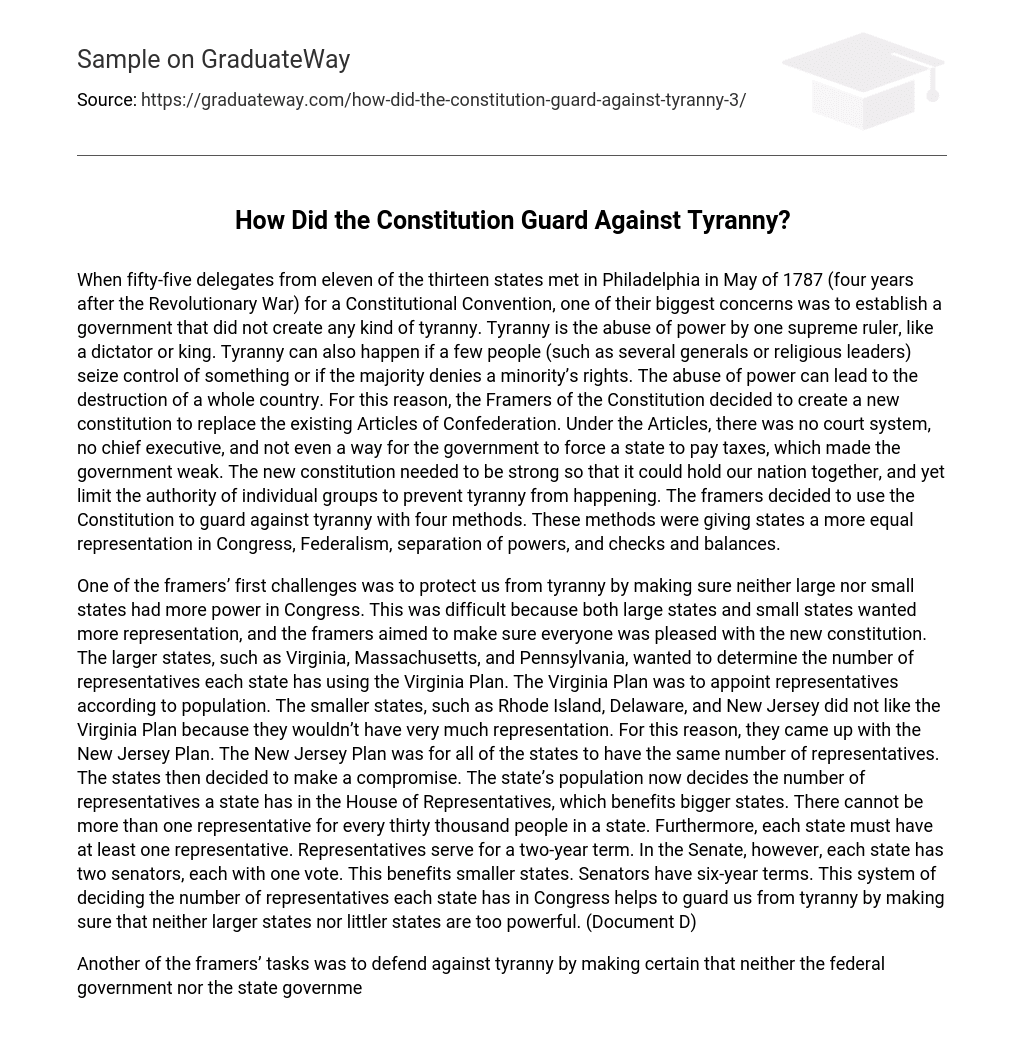In May 1787, delegates from eleven states gathered at the Constitutional Convention in Philadelphia with the goal of establishing a government that would prevent tyranny. Tyranny refers to the abuse of power by a supreme ruler or small group, which can lead to the downfall of an entire nation and deny the rights of others. The Framers of the Constitution aimed to replace the weak Articles of Confederation with a stronger constitution to avoid this outcome. The new constitution sought to unite the country while also placing limitations on certain groups’ authority. To safeguard against tyranny, four methods were incorporated into the Constitution: equal representation for states in Congress, Federalism, separation of powers, and checks and balances.
During the creation of the Constitution, the framers faced a challenge in preventing tyranny by maintaining a fair distribution of power in Congress between large and small states. The larger states supported assigning representatives based on population, while smaller states were concerned about limited representation under this system. In response, smaller states developed a plan for equal representation for all states. Ultimately, a compromise was reached where the number of representatives in the House of Representatives is determined by each state’s population favoring larger states while ensuring that every state has at least one representative and no more than one representative per every thirty thousand people. In contrast to the House of Representatives, each state is represented by two senators in the Senate regardless of their population size. These senators hold equal voting power and serve for a term of six years, benefiting smaller states by giving them an equal voice in decision-making.In summary, this system guarantees a fair distribution of power among states in Congress while also preventing the rise of tyranny by ensuring that neither larger nor smaller states gain excessive influence.
James Madison, who is also known as the “Father of the Constitution,” created Federalism in order to safeguard against tyranny. Federalism divides power between the federal government and state governments, offering a system of “double security” for protecting individuals’ rights and maintaining a separation of powers at both levels. Each government entity acts as a check on the other while still retaining self-control. The central government primarily focuses on national and global matters such as trade regulation, foreign relations, and defense forces. State governments handle local concerns such as establishing local governments, conducting elections, operating schools, implementing marriage and divorce laws, and overseeing in-state business activities. Both levels possess significant powers including taxation, borrowing money, establishing courts, and creating/enforcing laws. By preventing an excessive concentration of power at either level, Federalism serves as a safeguard against tyranny.
The Constitution’s framers had a purpose of preventing tyranny by dividing government powers, which was also a belief shared by Madison. Madison believed that if one entity held all the powers – legislative, executive, and judicial – it would be seen as tyrannical. Therefore, the framers established three separate branches of government. The first branch was Congress, which included the Senate and House of Representatives. Congress had responsibilities such as creating laws, printing money, declaring war, dealing with pirates, and collecting taxes. The second branch was the executive branch consisting of the President, Vice President, and cabinet members who were responsible for enforcing laws and negotiating treaties with other countries. Lastly, they created a judicial branch composed of both superior and inferior courts. This branch had the authority to interpret laws, declare them unconstitutional, and impose penalties for non-compliance. To prevent an accumulation of power that could lead to tyranny (Document B), individuals were prohibited from holding positions in multiple branches at the same time.
James Madison’s idea was to prevent tyranny by granting each branch of government the power to check and balance the others. The framers ensured this through various methods. For example, the legislative branch exercises control over the executive and judicial branches by approving nominations for cabinet seats and Supreme Court Justices made by the President, overriding a President’s veto, and impeaching the President to remove them from office. Similarly, the executive branch can check and balance the legislative and judicial branches by vetoing Congressional legislation and nominating judges. Furthermore, the judicial branch has authority over both the legislative and executive branches as they can deem laws and presidential acts unconstitutional. These checks and balances among the branches also aid in maintaining separation of powers since each branch has different roles.
The efforts of the Framers to draft a new constitution in place of the Articles of Confederation proved to be highly successful. Their contributions greatly benefited our nation, enabling America to be the first country to effectively guard against tyranny. Through the implementation of the small state – large state compromise, federalism, separation of powers, and checks and balances, they guaranteed that the United States of America would never succumb to the dangers of tyranny.





